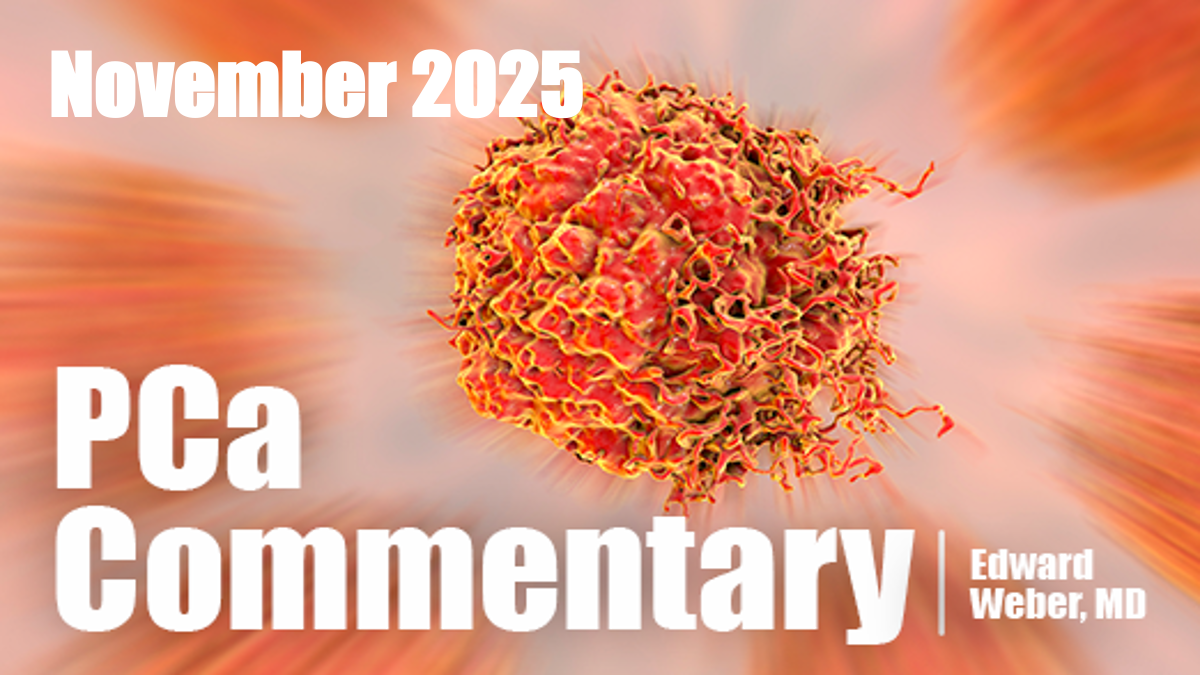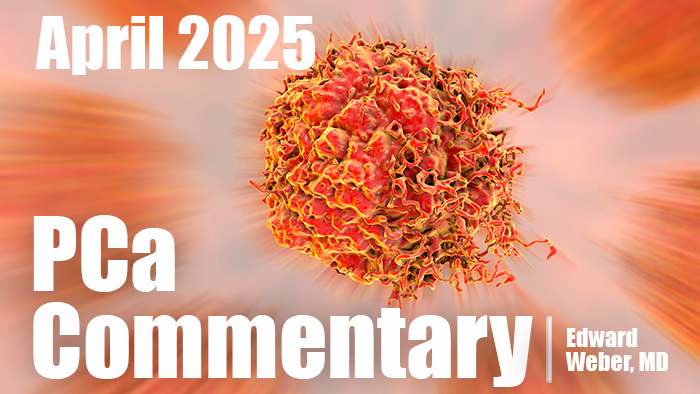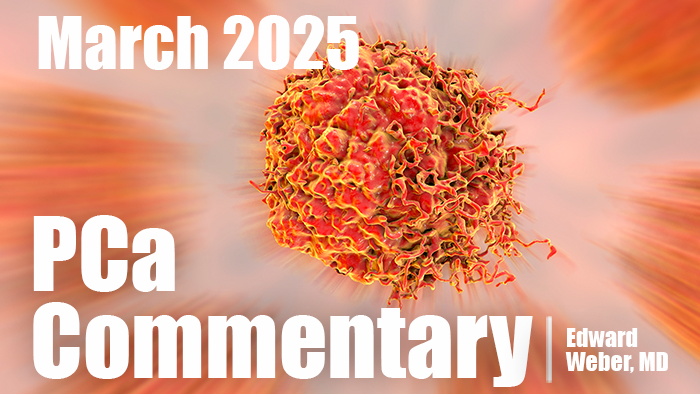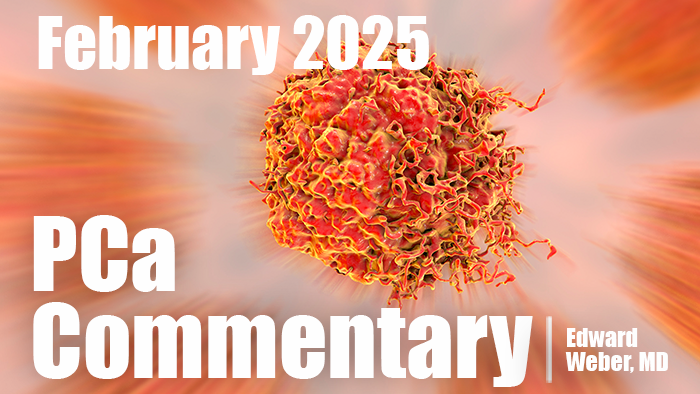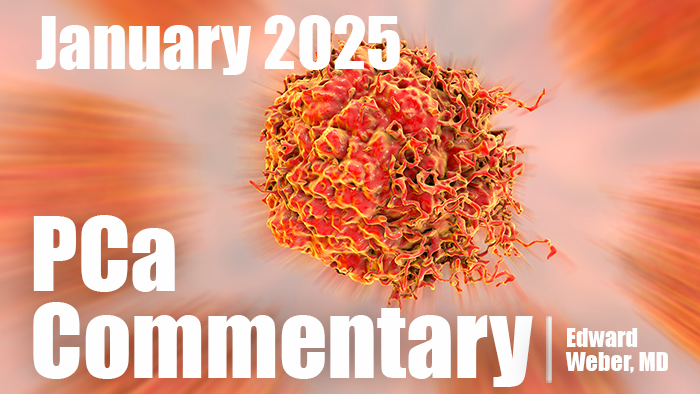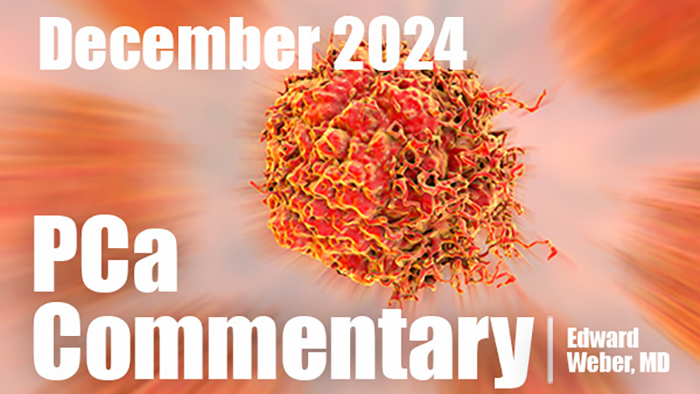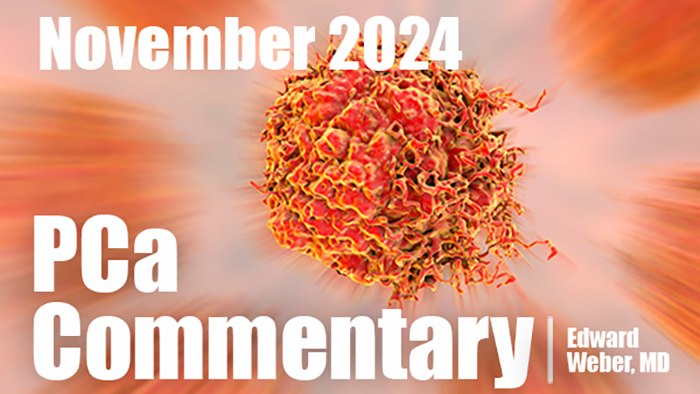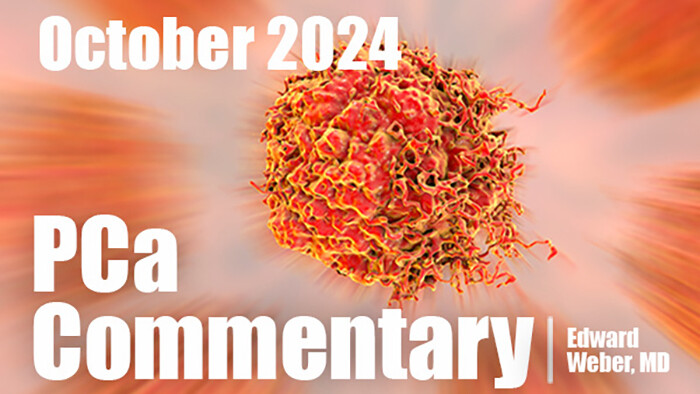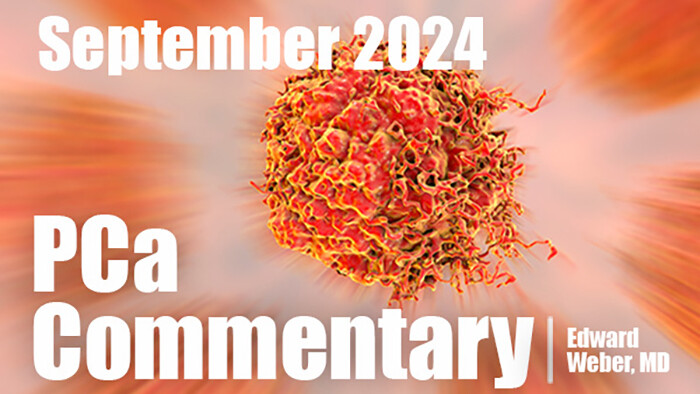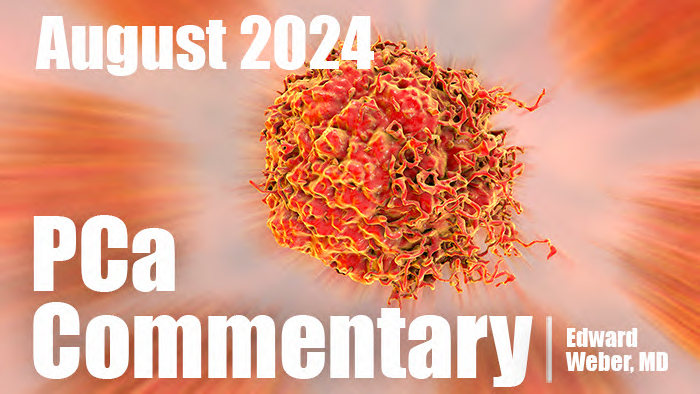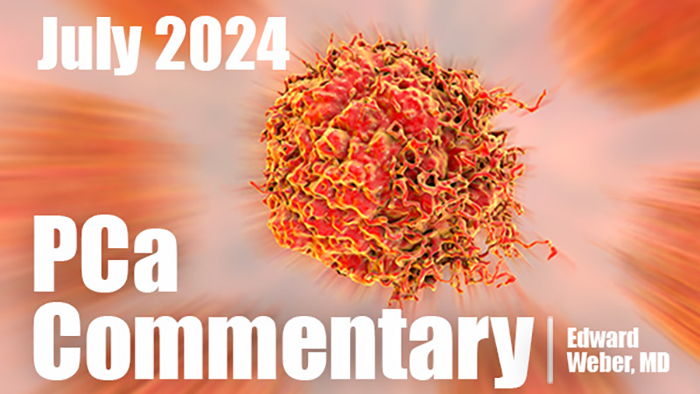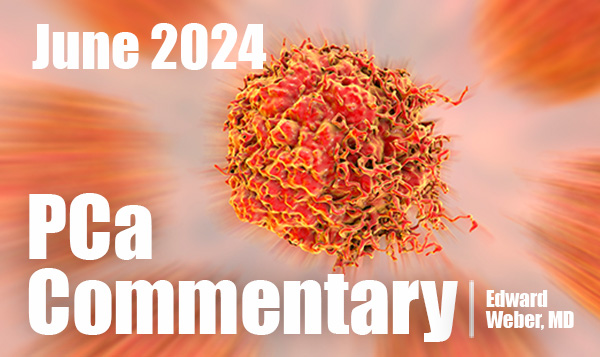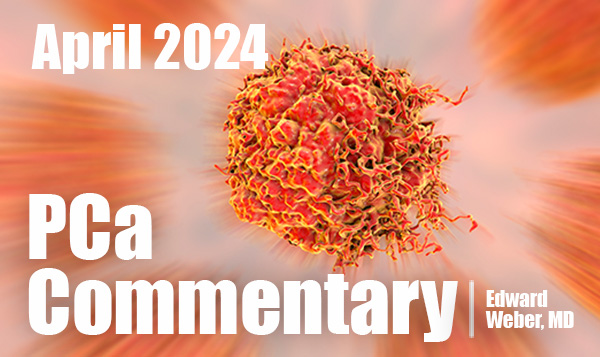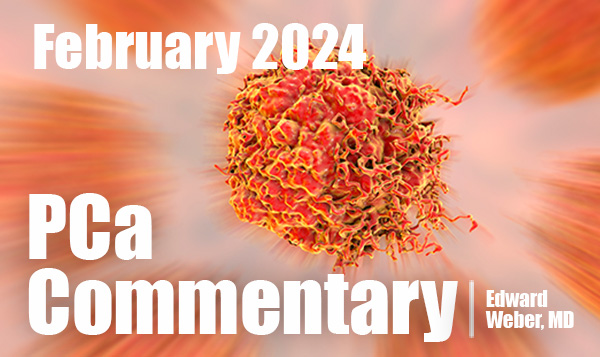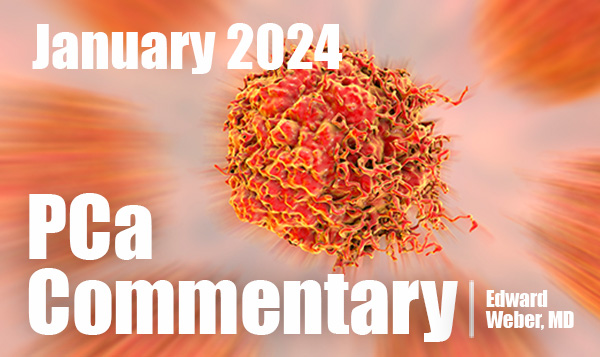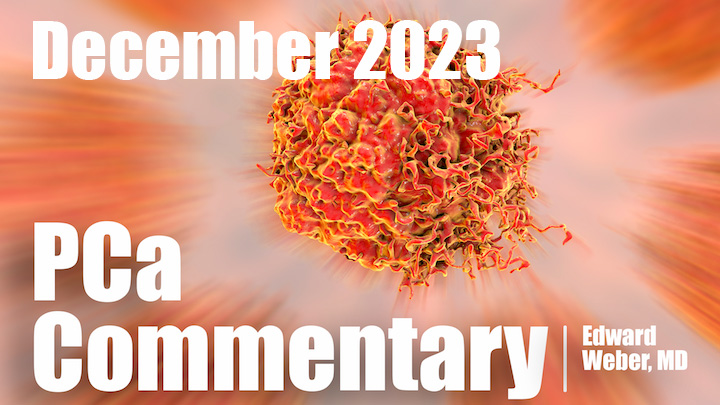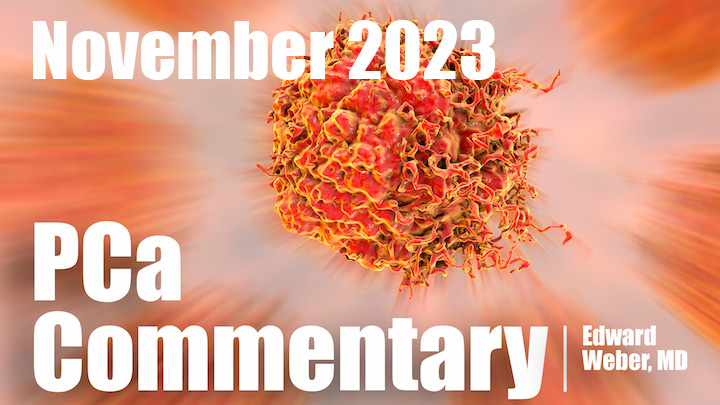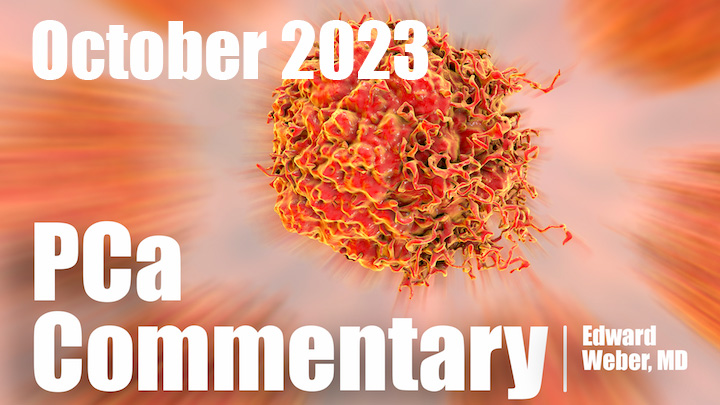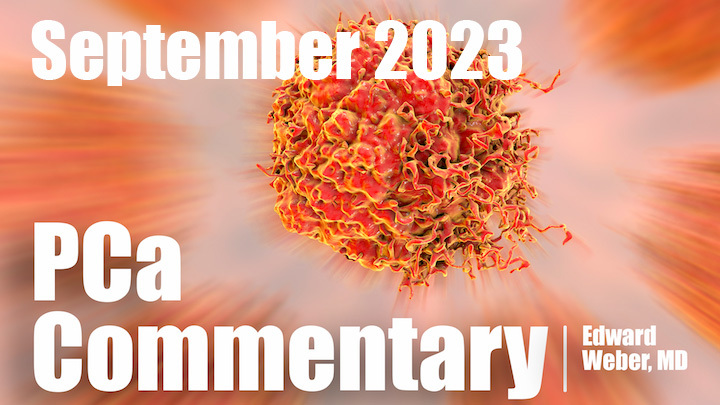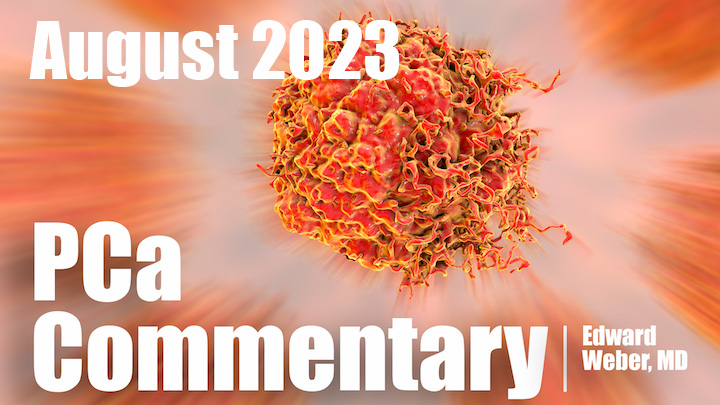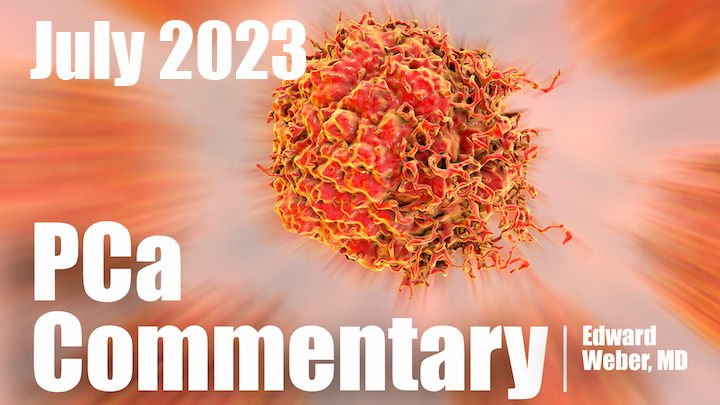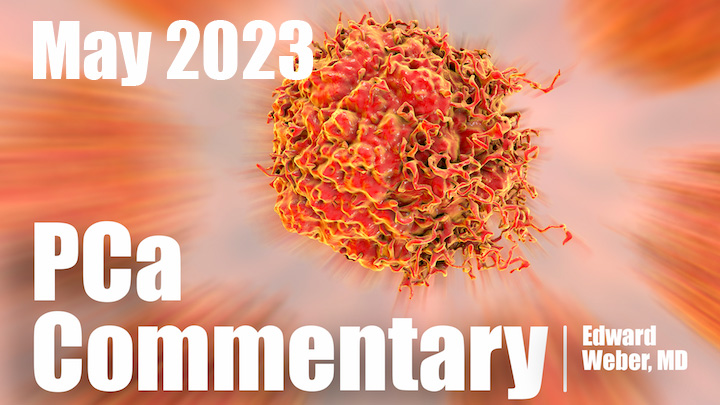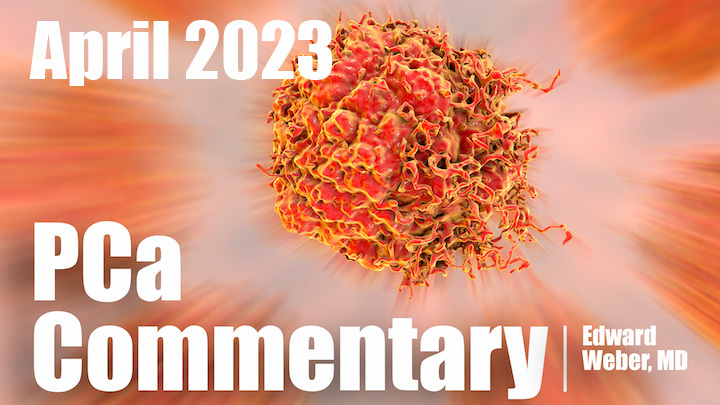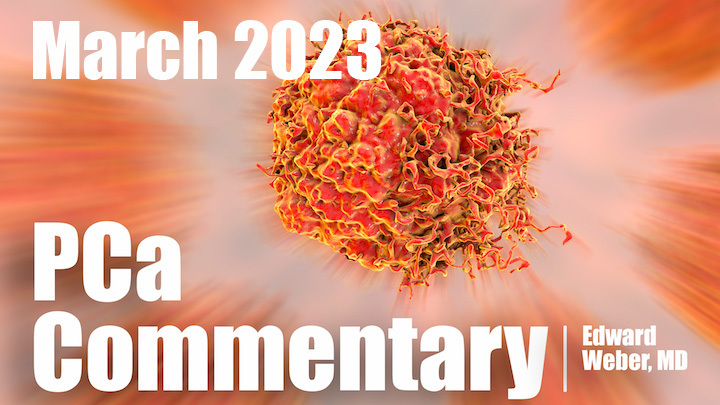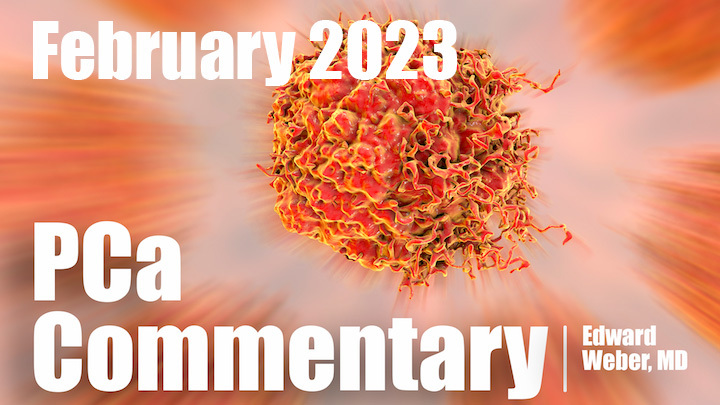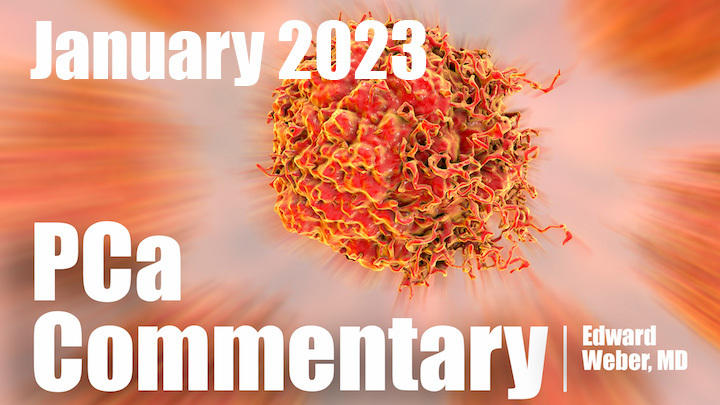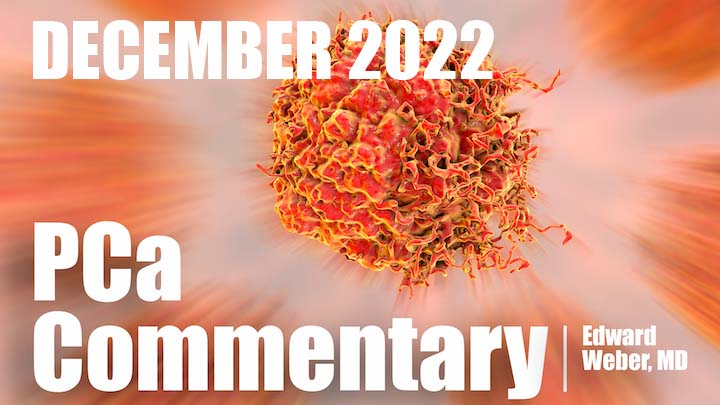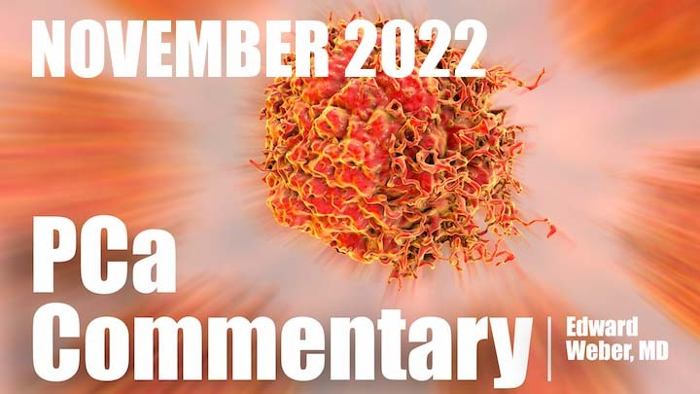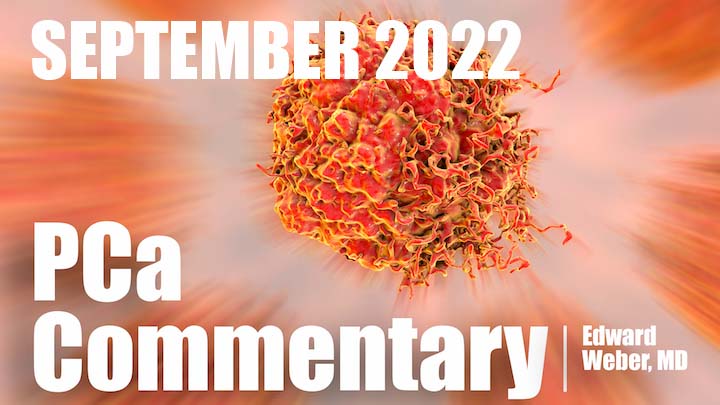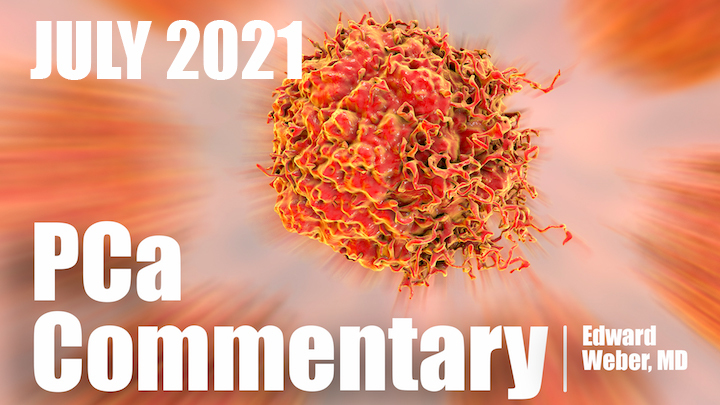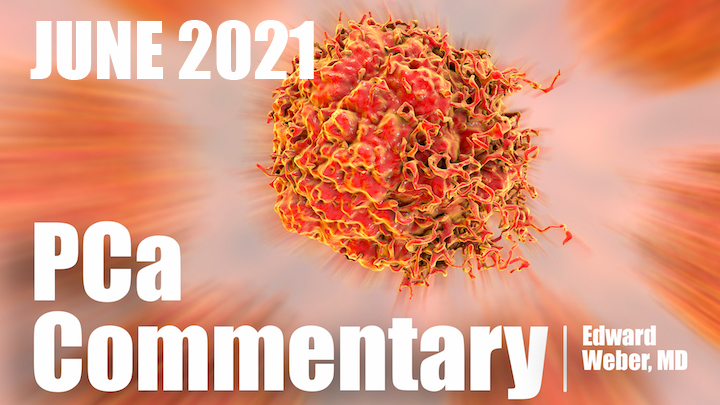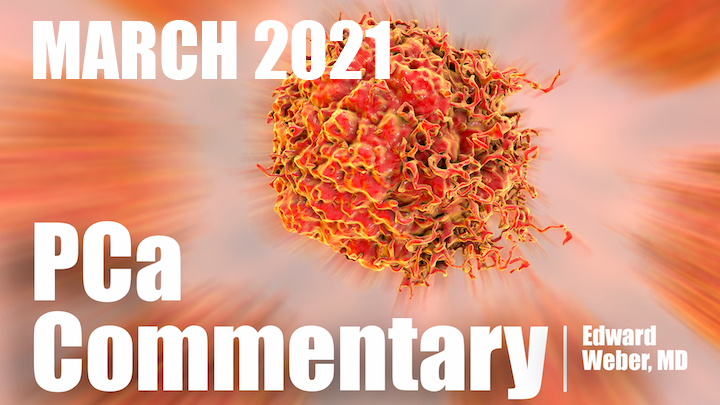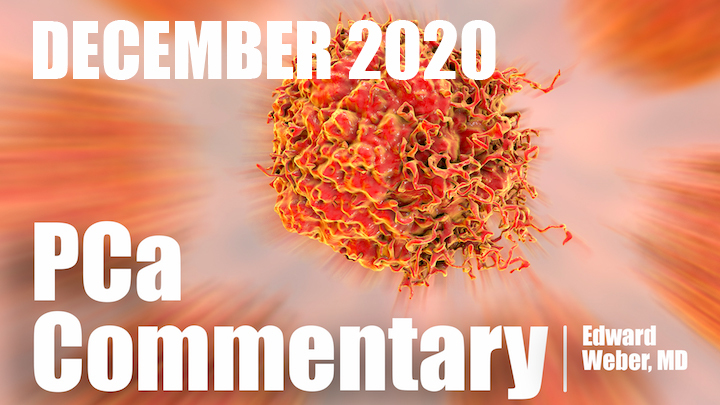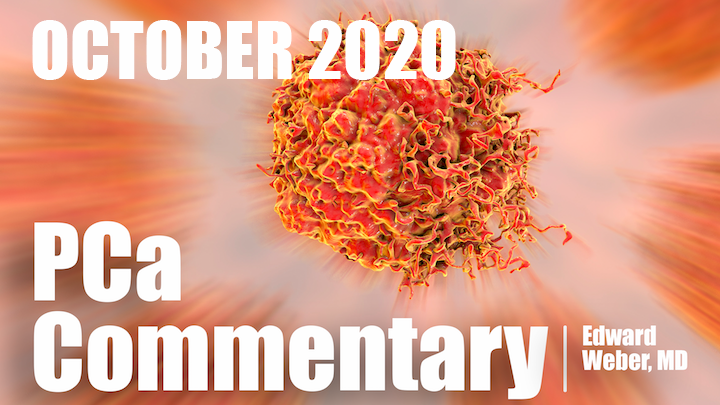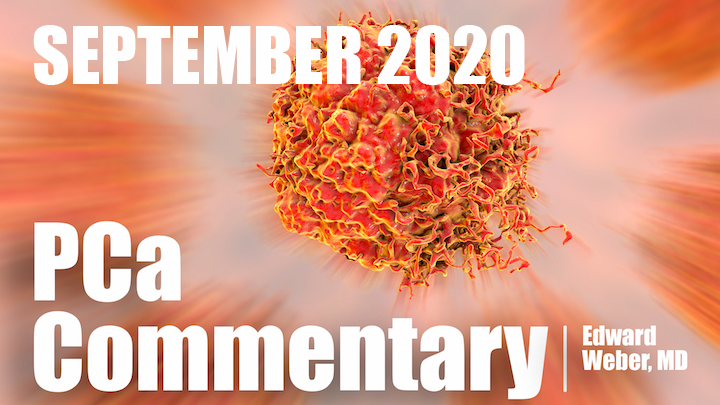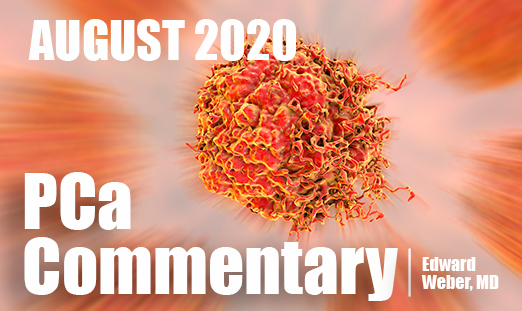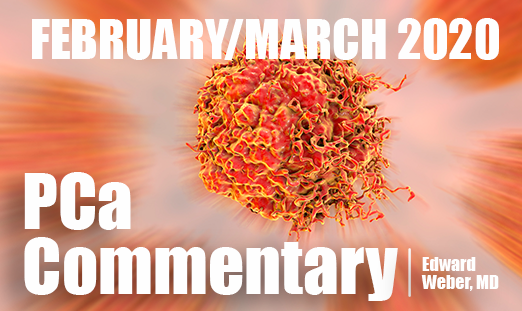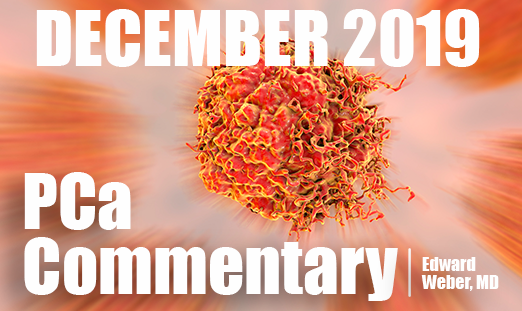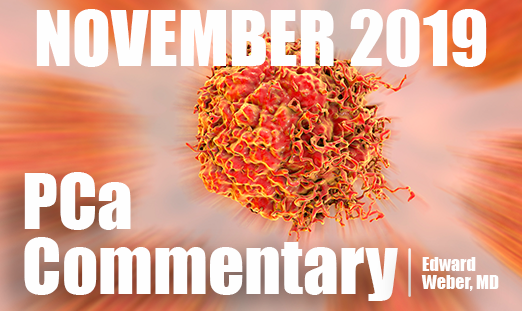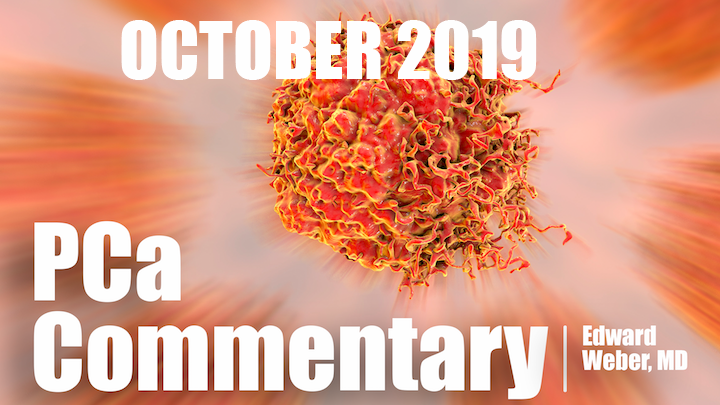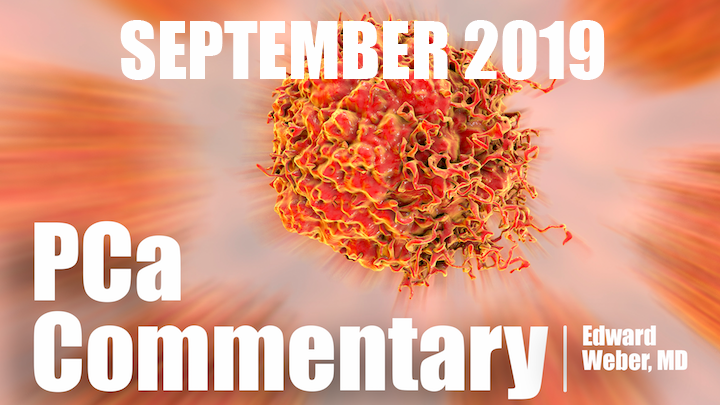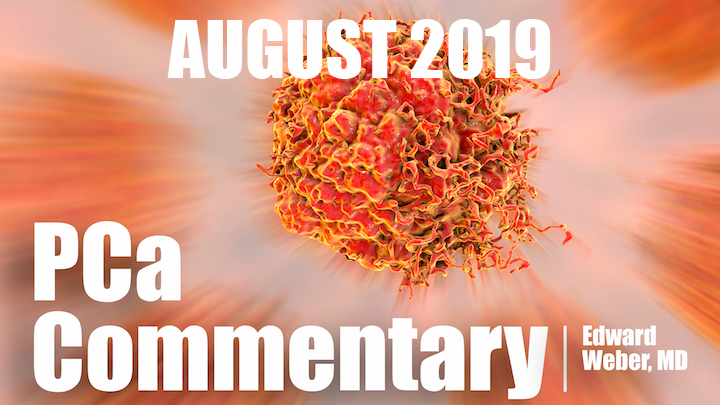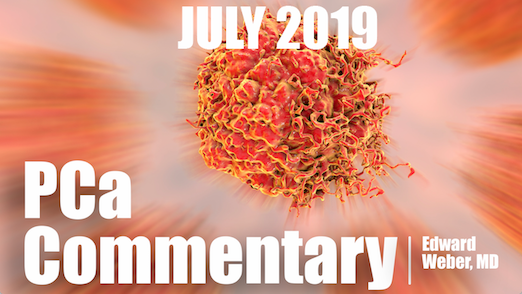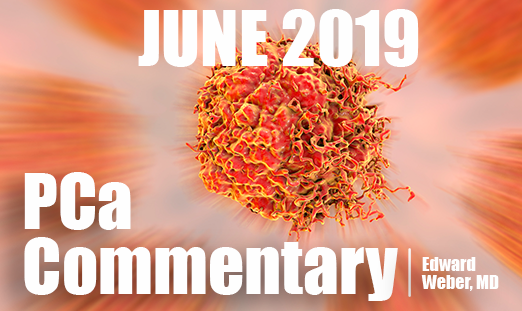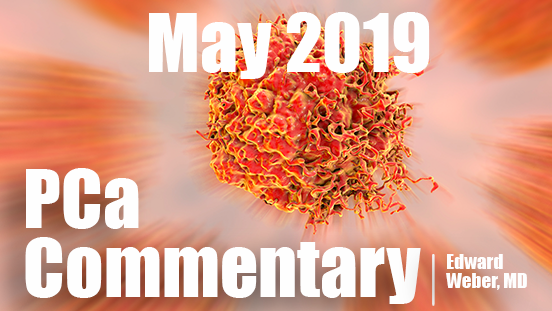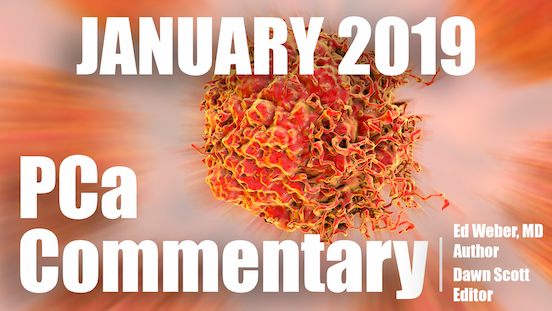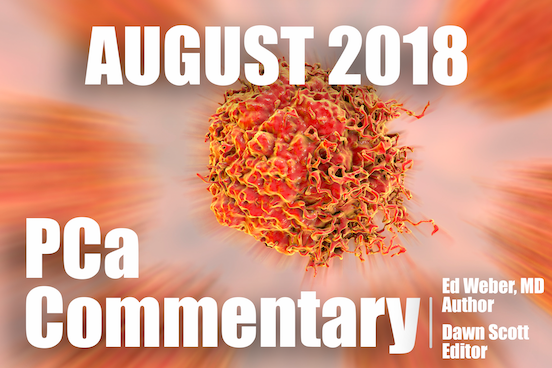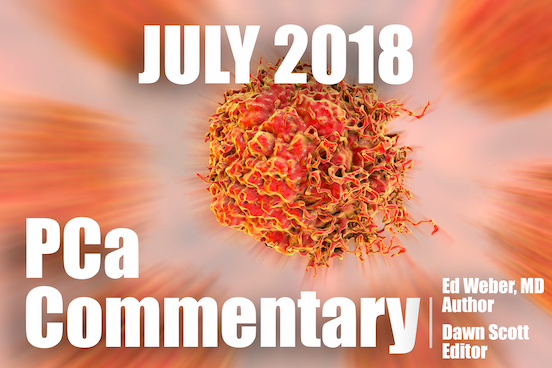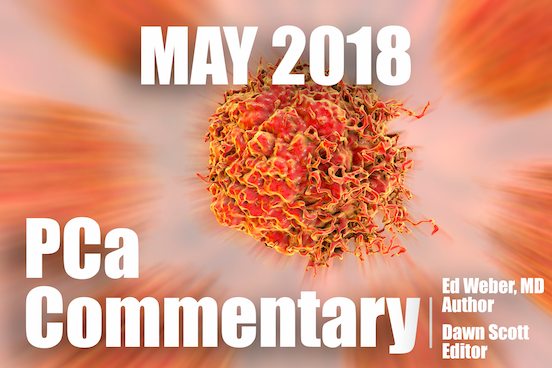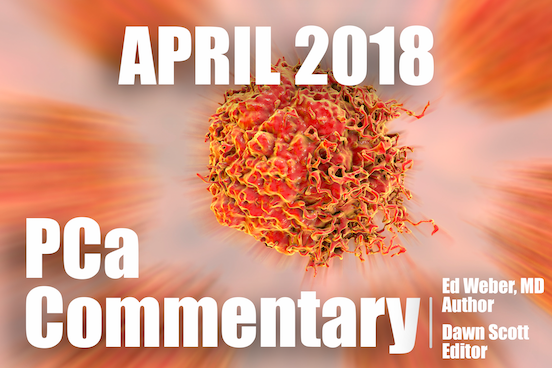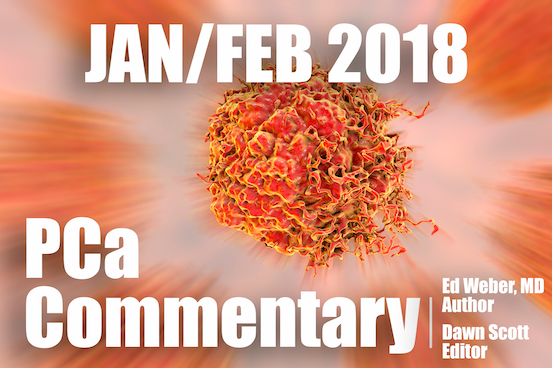
PCa Commentary | Volume 207 – November 2025
The Emergence of Genomic Classifiers in Risk Stratification for Management of Prostate Cancer
Increasingly, there have been advances in refining stratifications to better guide treatment decisions. Analysis of a cancer’s gene expression provides insight into a tumor’s behavior and aggressiveness, matching a therapy’s appropriateness, and allowing avoidance of unnecessary toxicity, inconvenience, and expense. This tailoring might indicate, for example, that adjuvant hormone suppression would be of minimal benefit or that chemotherapy is not appropriate.
PCa Commentary | Volume 206 – October 2025
The BRCA Family of Mutated DNA Damage Repair Genes Influence Therapy
A rapid increase has occurred in the discovery of biomarkers to guide therapeutic decisions. A mutated BRCA2 gene, for example, is a predictive biomarker that indicates greater cancer aggressiveness and a poor response to some therapies. But it also offers benefits when combined with other agents. Traditionally, these markers have been found by genomic analysis of tissues – prostate biopsies or prostatectomy specimens. Currently, biomarkers can be discovered in blood, urine, and circulating DNA. This Commentary will highlight some examples of biomarkers useful for guiding patient management.
PCa Commentary | Volume 205 – September 2025
The Venerable PSA: It Lacks Specificity for Distinguishing Significant Cancer, Which Is Better Addressed by Urine Genomics.
In 1970, the antigen PSA was discovered in semen and prostate tissue. In 1980, it entered clinical service to guide biopsies for suspected cancer and monitor prostate cancer treatment. Before this, prostate cancer was diagnosed, often at a late stage, by biopsies of prostate nodules or finding cancer in the transurethral resection specimens. In 1986, the FDA approved the PSA for monitoring treatment, and in 1994, it was FDA-approved for screening along with a rectal exam. Since then, it has been the mainstay for prostate cancer diagnosis and management.
PCa Commentary | Volume 204 – August 2025
Management of Transformed Neuroendocrine Prostate Cancer “tNEPC” — An Unmet Challenge.
Neuroendocrine cells are normal constituents of the prostate. They perform a regulatory role, influencing growth and differentiation. Spread throughout the body, they receive signals from the nervous system to secrete hormones that govern other systems.
Mutations in regular prostate adenocarcinoma cells can transform themselves and their neighbors into malignant neuroendocrine cancer cells (tNEPC). While there are rare cases (1%) wherein the entire prostate gland is overwhelmed by malignant NEPC cells, the usual situation is that, later in disease progression, due to mutations resulting from sequential therapies, 20% to 30% of adenocarcinoma cells are transformed into aggressive tNEPC. These cells do not secrete PSA, nor do they express the cell-surface prostate-specific membrane antigen (PSMA). They are unaffected by androgen suppression and escape Pluvicto therapy, which requires the expression of the PSMA antigen to guide 177Lutetium to its target.
PCa Commentary | Volume 203 – July 2025
A PRIMER: PROTACs (Proteolysis Targeting Chimeras) – Drugs That Specifically Target the Androgen Receptor for Destruction
Research in 1941 by the physiologist Charles Higgins first identified that prostate cancer develops and is driven by testosterone (T) activating the androgen receptor. And ever since, the management of the disease has involved inhibiting this activation by suppressing it with LHRH agonists (e.g., Lupron and others), LHRH antagonists (e.g., Firmagon or Relugolix), and more recently, with anti-androgens (e.g., Xtandi, Nubeqa, etc.) and the androgen synthesis inhibitor, Zytiga. Disease suppression is achieved by all these therapies, sometimes with dramatic PSA reductions, but unfortunately, the effect is often short-lived. Rapid resistance to androgen deprivation develops because of various mechanisms over months to several years, or much longer for fortunate men. Prolonged use of hormone suppressors is associated with considerable adverse effects. Even short courses of 4 – 6 months carry significant toxicity and require months after discontinuation to achieve a return of testosterone to baseline levels.
PCa Commentary | Volume 202 – June 2025
FDA approves [177Lu]-PSMA-617 for Early Use Based on the PSMAfore Clinical Trial; and 225-Actinium Radioligand Therapies Under Development for Metastatic Castration-Resistant Prostate Cancer
The PSMAfore protocol was FDA approved on March 28, 2025, moving the option of using [177Lu]-PSMA-617 front-forward in early progressive metastatic castration-resistant prostate cancer (mCRPC). Currently, metastatic castration-resistant PC is treated with Lupron alone (or a similar drug such as Orgovyx, Degarelix, or Zoladex) combined with an androgen receptor pathway inhibitor (ARPI) such as Enzalutamide, Apalutamide, or Darolutamide; or Zytiga, an androgen biosynthesis inhibitor.
PCa Commentary | Volume 201 – May 2025
UPDATE of the PATCH TRIAL — and Information About Transdermal Estradiol Usage.
Brief Review of Findings in the Original Langley Abstract Presented at Eur Soc Med Oncol, Sept. 2024:
The PATCH Trial established that transdermal estradiol (tE2) patches were equally effective as Lupron in achieving metastasis-free and overall survival in newly diagnosed men with locally advanced (Stage M0) or node-positive prostate cancer (Stage N1), and also in men relapsing with PSA doubling times of < 9 months and PSAs > 20 ng/mL. Patches lowered testosterone (T) to an equal extent as Lupron (but more rapidly) and in each group T was maintained at < 50 ng/dL and estradiol (E2) was maintained at >250 pmol/L ( normal E2 in adult males ~130 pmol — Chadid et al., J Endocr Soc. 2019). E2 was associated with fewer hot flushes (44% vs 89%), improved bone density, and both groups had similar low rates of cardiovascular adverse effects ( ~ 7-10 each). Gynecomastia developed in 85% of men on patches vs. 42% on Lupron, which was partially prevented by pre-treatment radiation to breast tissue. Langley concluded, “Transdermal estradiol (tE2) should be a standard-of-care ADT option in MO and N1 disease.” (Link to Vol # 195)
PCa Commentary | Volume 200 – April 2025
Focal Therapy of Prostate Cancer — An Emerging Technique for Initial Treatment of Localized Disease
With the increasing accuracy of imaging to define the volume and boundary of a solitary lesion, interest and research in focal ablation have increased. The outcomes of multiple techniques have been reported, including high-frequency ultrasound, cryoablation, brachytherapy, electroporation, laser ablation, and stereotactic body radiation therapy (SBRT). Focal therapy could be considered as occupying a mid-position between active surveillance and radical treatment, allaying anxiety about intervention delay in active surveillance.
PCa Commentary | Volume 199 – March 2025
Prostate-directed Therapy in Oligo-Metastatic Hormone-Sensitive Prostate Cancer (omHSPC) — The New Paradigm.
A consensus has emerged that in mHSPC prostate-directed therapy improves overall survival. This treatment is appropriate in the 20% – 30% of men with high-risk or locally advanced cancer (Gleason Score 8 – 10, PSA >20 ng/mL and local spread around the gland) who, at diagnosis, have five or fewer metastatic sites beyond the pelvis (M1 disease). This condition is termed oligometastatic. STAMPEDE is the seminal study that demonstrated the benefit of radiation therapy to the prostate in omHSPC.
PCa Commentary | Volume 198 – February 2025
“Pluvicto” (177Lutetiun-PSMA-617) Therapy for Prostate Cancer — What’s Coming Up in the Future for Pluvicto? Updated Results, Patient Selection Guidance, Early Use and 177Lu in Combination.
Pluvicto was approved in March 2022 for therapy in men with heavily pretreated castration resistant metastatic prostate cancer, and since then, it has become a frequently prescribed life-prolonging treatment. Sartor et al., NEJM 2021, reported that the median imaging-based progression-free survival for 177Lu PSMA was 8.7 months vs. 3.4 for ADT alone, and the median overall survival was 15.3 months vs.11.3 for ADT. Quality of life was similar. Pluvicto is administered via a short IV infusion every 6 weeks for 4-6 cycles.
PCa Commentary | Volume 197 – January 2025
ANDROGEN DEPRIVATION THERAPY (ADT)— When —early or delayed, —and how.
After primary therapy about 30% of men who are at high risk for recurrence experience disease progression — indicated by a PSA rising above their post-treatment baseline value. These are men whose initial PSA was above ~20 ng/mL with Gleason scores of 4+3 or higher and a PSA doubling time of < 9 months. This state of rising PSAs applies to two groups of men: those with rising PSAs before androgen deprivation therapy, termed non-metastatic hormone-sensitive PC (nmHSPC), and a second state termed non-metastatic castration-resistant PC (nmCRPC)., i.e., a rising PSA despite a castration level testosterone. The second category is a transient condition since as many as 80% of these men (based on the EMBARK trial) harbor low-burden metastatic disease found on PSMA scanning, despite having been negative on standard CT, bone scans, and MRIs. Clinical management of these two conditions has been heavily researched without a consensus regarding management. This Commentary will discuss the first state, i.e., nmHSPC, which, upon intervention, can result in both benefits – by delaying metastases, and harm — because of a man experiencing adverse effects due to sustained androgen deprivation. Achieving an acceptable balance between the two is the compromise to be determined by a patient and his physician.
PCa Commentary | Volume 196 – December 2024
MY PROSTATE TEST
A Risk Stratification Model for Outcome Post Prostatectomy; Eligibility for Active Surveillance; and Relative Benefit of Short-Term ADT Added to Radiation Therapy – all combined in the “ArteraAI Prostate Test”
Given extensive data sets composed of fully defined characteristics of the patients likely to utilize the model, AI can make an accurate outcome prediction for an individual patient. These requirements were met by Spratt et al. in developing the first iteration of “My Prostate Test” by ArteraAI, in their article “Artificial Intelligence Predictive Model for Hormone Therapy in Prostate Cancer,” NEJM Evidence, June 2023.
PCa Commentary | Volume 195 – November 2024
NEW CLINICAL DEVELOPMENTS:
- The PATCH Trial
- Outcome of Active Surveillance in the PASS Study
- Artificial Intelligence in Patient Selection for Active Surveillance.
Lupron was approved for the treatment of metastatic prostate cancer in 1985 based on several seminal articles establishing Lupron as equivalent to orchiectomy and oral estrogen but having fewer adverse effects than estrogen. Tolis, et al. (Proc Natl Acad ScDLi USA, 1982) found Lupron effective in lowering serum testosterone to castrate levels to a similar extent as surgical castration (Labrie, et al. (J Urol 1984). Chodak, et al. (J Urol. 1896) found Lupron equivalent to oral estrogen and surgical castration in lowering testosterone and controlling metastatic disease. These endorsements of Lupron for the treatment of metastatic prostate cancer represented a significant sea change in the management of the disease and continue to be the standard of care.
PCa Commentary | Volume 194 – October 2024
The EMBARK TRIAL: Enzalutamide (Xtandi) Monotherapy for Non-metastatic Hormone Sensitive Prostate Cancer.
The commentary discusses the EMBARK trial, which offers a useful model of options as to how to treat stage M0 prostate cancer patients who are at high risk for recurrence because of rapidly rising PSA values. Additional analysis of EMBARK found that 80+ % of men were already positive for metastases by PET/CT. The issue of when to initiate treatment for the remaining ~20% in EMBARK and other men with rising PSAs negative on scanning is complex and awaits clarification.
PCa Commentary | Volume 193 – September 2024
Tumor-Derived Exosomes – a Prostate Cancer Cell-to-Cell Communication System – a Primer
The commentary discusses the effects of androgen suppression (via agents like Lupron) and estrogen on bone density and fracture risk in men with prostate cancer. It highlights the PATCH trial, comparing the cardiovascular and bone health outcomes of using transdermal estrogen patches (tE2) versus LHRH agonists like Lupron. The findings suggest that tE2 may improve bone density and overall quality of life, potentially offering a new approach to managing metastatic prostate cancer.
PCa Commentary | Volume 192 – August 2024
Androgen Suppression, Estrogen, Bone Density and Fracture Risk
The commentary discusses the effects of androgen suppression (via agents like Lupron) and estrogen on bone density and fracture risk in men with prostate cancer. It highlights the PATCH trial, comparing the cardiovascular and bone health outcomes of using transdermal estrogen patches (tE2) versus LHRH agonists like Lupron. The findings suggest that tE2 may improve bone density and overall quality of life, potentially offering a new approach to managing metastatic prostate cancer.
PCa Commentary | Volume 191 – July 2024
Radioligand Therapy (RLT): 177Lu-PSMA-617: Pluvicto Update and Introducing 225-Actinium-617 RLT
This Commentary discusses a comprehensive discussion of RLT presented by Viscuse et al., J Nucl Med 2024: “Clinical Management of Advanced Prostate Cancer: Where Does Radiopharmaceutical Therapy Fit in the Treatment Algorithm?
PCa Commentary | Volume 190 – June 2024
PARADIGM SHIFT — Changes in the Management of De Novo Metastatic
Hormone-Sensitive Prostate Cancer (mHSPC)
This Commentary discusses current literature on the identification of optimal oligometastatic prostate cancer candidates for metastasis directed therapy.
PCa Commentary | Volume 189 – May 2024
Non-Metastatic Castration-Resistant Prostate Cancer:
Management Options, Associated Adverse Effects, and Treatment Outcomes.
This Commentary discusses non-metastatic castration-resistant PCa management options, associated adverse effects, and treatment outcomes.
PCa Commentary | Volume 188 – April 2024
Prostate Cancer Heterogeneity — Clinical Consequences and Therapeutic Relevance.
This Commentary discusses patient selection for acitve surveillance for PCa, outcomes, and monitoring for Gleason Grade progression.
PCa Commentary | Volume 186 – February 2024
ACTIVE SURVEILLANCE: Patient Selection, Outcomes, and Monitoring for Gleason Grade Progression.
This Commentary discusses patient selection for acitve surveillance for PCa, outcomes, and monitoring for Gleason Grade progression.
PCa Commentary | Volume 185 – January 2024
Identifying Optimal Oligometastatic PCa
Candidates for Metastasis Directed Therapy
This Commentary discusses current literature on the identification of optimal oligometastatic prostate cancer candidates for metastasis directed therapy.
PCa Commentary | Volume 184 – December 2023
Focal Therapy for Localized Prostate Cancer
This Commentary discusses current literature on focal brachytherapy and focal cryotherapy for the treatment of localized prostate cancer.
PCa Commentary | Volume 183 – November 2023
Artificial Intelligence in Prostate Cancer
This Commentary discusses current literature on artificial intelligence in prostate cancer diagnosis, risk stratification, and prediction of outcomes.
PCa Commentary | Volume 182 – October 2023
Oligometastatic Prostate Cancer: Metastasis Directed Therapy (MDT) – Treatment Options
This Commentary discusses current literature on oligometastatic prostate cancer and the use of metastasis-directed therapy (MDT) as a treatment option.
PCa Commentary | Volume 181 – September 2023
PSMA PET/CT Staging of Advanced PCa and AI-Guided Androgen Deprivation Therapy
This Commentary discusses current literature on PSMA PET/CT staging and AI-guided ADT for advanced prostate cancer diagnosis and treatment.
PCa Commentary | Volume 180 – August 2023
Digital Pathology and Artificial Intelligence
This Commentary discusses current literature on digital pathology and artificial intelligence in prostate cancer diagnosis and treatment.
PCa Commentary | Volume 179 – July 2023
Neuroendocrine Prostate Cancer: A Challenging Transformation in Late Disease
This Commentary discusses current literature on treatment-induced neuroendocrine prostate cancer (t-NEPC.)
PCa Commentary | Volume 178 – June 2023
Radioligand Therapy (RLT): A View Into the Future
This Commentary reviews and discusses current literature on the use of Radioligand Therapy (RLT ) in treating prostate cancer.
PCa Commentary | Volume 177 – May 2023
Decipher: Predicting Prognosis and Assisting Treatment Decisions
This Commentary discusses Decipher, a genomic risk-stratifier that estimates prognosis on the basis of the unique molecular characteristics of a man’s prostate cancer, and can offer guidance in treatment decisions.
PCa Commentary | Volume 176 – April 2023
PARP Inhibition with Olaparib: A Potential New Indication for First-line Therapy for Metastatic Castration-Resistant Prostate Cancer
This Commentary reviews the underlying biology of PARP inhibitors and data supporting olaparib plus abiraterone as first-line therapy for mCRPC.
PCa Commentary | Volume 175 – March 2023
METASTATIC HORMONE SENSITIVE PROSTATE CANCER (mHSPC):
Many Treatment Options
This Commentary discusses the results of the ARASENS and PEACE-1 trials and their ramifications for treatment regimens for mHSPC.
PCa Commentary | Volume 174 – February 2023
MANAGING BIOCHEMICAL FAILURE AFTER RADIATION THERAPY — The Importance of Considering Both PSA and PSA Doubling Time.
This Commentary discusses the importance of considering both PSA and PSA doubling time for determining biochemical recurrence.
PCa Commentary | Volume 173 – January 2023
SEQUENCING BAT WITH XTANDI: An Effective Option
This Commentary discusses Bipolar Androgen Therapy: an effective, but likely underused, option in the sequence of treatments for mCRPC.
PCa Commentary | Volume 172 – December 2022
METASTASES DIRECTED THERAPY (MDT):
Can Concomitant Hormone Suppression Be Avoided?
This Commentary discusses selecting men for MDT+ADT versus MDT alone in the oligometastatic prostate cancer space.
PCa Commentary | Volume 171 – November 2022
Nonmetastatic Castration-Resistant Prostate Cancer: The “Ides” of Androgen Receptor Inhibition — Enzalutamide, Apalutamide and Darolutamide.
This Commentary explores treatment regimens combining enzalutamide, apalutamide, or darolutamide with androgen deprivation for nmCRPC.
PCa Commentary | Volume 169 – September 2022
ANDROGEN DEPRIVATION THERAPY (ADT) AND RADIOTHERAPY: Basic Mechanisms and New Developments.
This Commentary looks at ADT and radiotherapy, as well as evolution of cellular resistance to ADT therapy and potential treatment.
PCa Commentary | Volume 166 – June 2022
CAR-T CELL IMMUNOTHERAPY OF PROSTATE CANCER: PROMISING, BUT CURRENTLY ONLY A “WORK-IN-PROGRESS”
This Commentary looks at developing research on how to use CAR-T cell immunotherapy to treat prostate cancer.
PCa Commentary | Volume 165 – May 2022
Lutetium-177—PSMA-617 Therapy: Now FDA-Approved and to Be Available Shortly: The Treatment in Context
This Commentary looks at Lutetium-177 PSMA-617 therapy radioligand therapy for metastatic castration-resistant prostate cancer.
PCa Commentary | Volume 164 – April 2022
Recurrent Prostate Cancer – An Emerging Management Trifecta: PSMA PET/CT; Oligometastatic Cancer; Focal CyberKnife Treatment.
This Commentary looks at an emerging management trifecta for recurrent prostate cancer: PSMA PET, oligometastatic cancer & focal therapy.
PCa Commentary | Volume 163 – March 2022
DECIPHER GENOMIC CLASSIFIER: Its Risk Predictions Assist in Decision-Making.
This Commentary looks at how the Decipher assay assists in decision-making for how to treat patients with prostate cancer.
PCa Commentary | Volume 162 – February 2022
ACTIVE SURVEILLANCE: Patient Selection and Monitoring – An Update
This Commentary gives an update on patient selection and monitoring for prostate cancer active surveillance.
PCa Commentary | Volume 161 – January 2022
BIPOLAR ANDROGEN THERAPY (BAT): A Treatment Option for Metastatic Castration-Resistant Prostate Cancer (mCRPC)
This Commentary looks at bipolar androgen therapy (BAT) for metastatic castration-resistant prostate cancer (mCRPC).
PCa Commentary | Volume 160 – December 2021
Gene Mutations in the BRCA Family and PARP Inhibition Therapy
This Commentary looks at gene mutations in the BRCA family and PARP inhibition therapy for advanced prostate cancer.
PCa Commentary | Volume 159 – November 2021
GENE EXPRESSION PROFILING: Application of Genomics to Therapy Selection for Patients with Metastatic Hormone-Sensitive Prostate Cancer (mHSPC).
This Commentary looks at the application of genomics to therapy selection for patients metastatic hormone-sensitive prostate cancer (mHSPC).
PCa Commentary | Volume 158 – October 2021
Therapy of the Primary Tumor in Newly Diagnosed Metastatic Hormone-Sensitive Prostate Cancer (mHSPC): To Treat or Not to Treat. That is the Question.
This Commentary considers the benefits of therapy of the primary tumor in de novo mHSPC, especially as this patient population grows.
PCa Commentary | Volume 157 – September 2021
Metastatic Hormone Sensitive Prostate Cancer (mHSPC): Increasing in Incidence; Treatment Options Evolving
This Commentary considers the increased incidence of and evolving treatment options for metastatic hormone-sensitive prostate cancer.
PCa Commentary | Volume 156 – August 2021
PYLARIFY — A New PET Imaging Agent for Staging Primary Prostate Cancer and Recurrence
This Commentary looks at Pylarify, a new PET/CT imaging agent for staging primary prostate cancer and recurrence.
PCa Commentary | Volume 155 – July 2021
HOT FLASHES: Physiology and Treatment — A Basic Primer
This Commentary looks at causes and management options for hot flashes, a common side effect of ADT treatment for prostate cancer.
PCa Commentary | Volume 154 – June 2021
Treatment-Induced Neuroendocrine Prostate Cancer – Tough to Diagnose and Tough to Treat: A Primer but Concluding with a Review of a New Study Offering Hope.
This Commentary looks at the current state of causes, diagnosis, and treatment for neuroendocrine prostate cancer.
PCa Commentary | Volume 153 – May 2021
PSMA Targeted RadioIigand Therapy for Metastatic Prostate Cancer: Where We Currently Stand and Where Research is Heading
This Commentary provides an overview of PSMA-targeted radioligand therapy with Lutetium-177 or Actinium-225 and positive impact on progression-free survival.
PCa Commentary | Volume 152 – April 2021
GENOMIC SEQUENCING and GENOMIC CLASSIFIERS: Aids to Decision Making.
This Commentary provides a primer on using genomic classifiers and genomic sequencing to guide management decisions for prostate cancer.
PCa Commentary | Volume 151 – March 2021
OLIGOMETASTATIC PROSTATE CANCER: Metastases Directed Therapy – Patient Selection, Imaging and Outcomes
This Commentary will addresses the guidance from four clinical trials regarding patient selection and imaging choices to best select patients most likely to benefit from MDT.
PCa Commentary | Volume 148 – December 2020
ACTIVE SURVEILLANCE – What’s New
This Commentary discusses Active surveillance (AS) as an increasingly recommended strategy for carefully selected men with a biopsy diagnosis of low grade, localized prostate cancer.
PCa Commentary | Volume 147 – November 2020
OLAPARIB and RUCAPARIB (PARP inhibitors)
This Commentary discusses how olaparib and rucaparib offer a needed additional treatment option for men with mCRPC.
PCa Commentary | Volume 146 – October 2020
Radium-223 (Xofigo); A Radioisotope Treatment for Prostate Cancer Metastatic to Bone. The radiobiology of Radium-223 suggests greater effectiveness when used early in metastatic castration-resistant prostate cancer (mCRPC).
The August issue of PCa Commentary This Commentary discusses how radium-223 therapy for mCRPC prolongs survival, improving with earlier use and when combined with other agents.
PCa Commentary | Volume 145 – September 2020
PSA, PSA Dynamics, and Advances in Imaging: PSA and the PSADT (PSA doubling time) Guide the Management of Prostate Cancer.
The August issue of PCa Commentary discusses how advances in imaging are detecting metastatic prostate cancer at increasingly lower PSA levels in men who have undergone radical prostatectomy and radiation therapy. Dr. Weber details how imaging techniques such as the Ga68- PSMA PET/CT-11 and subsequent refinements are finding metastatic disease at lower than previously expected PSA levels (below 0.2 ng/mL), and how PSA doubling time (PSADT) is now being used to guide the application of hormone or chemotherapy in these men.
PCa Commentary | Volume 144 – August 2020
THE CHECKPOINT INHIBITORS – In Search of a Role in the Treatment of Prostate cancer: The Current Status
The August issue of PCa Commentary discusses the current status of using checkpoint inhibitors for treating prostate cancer, including results from the Keynote-028 and Keynote-199 looking at the efficacy of pembrolizumab in heavily penetrated patients. He further discusses results related to the BRCA family of gene mutations, links between the gut microbiome and checkpoint inhibitors, as well as detailing two current clinical trials (Keynote 365 and Checkmate 9KD) examining combination therapy in mCRPC patients.
PCa Commentary | Volume 143 – February / March 2020
ANTI-PSMA 177-LUTETIUM RADIOLIGAND THERAPY:
An Update on Outcomes; the Vision Trial; and Future Directions
The February / March issue of PCa Commentary discusses using anti-PSMA 177-lutetium radioligand therapy for treating advanced metastatic prostate cancer. Dr. Weber examines the background of this therapy, early trials, and details the results of the VISION Trial. He further examines future implications and possibilities for this therapy in treating advanced metastatic prostate cancer.
PCa Commentary | Volume 142 – January 2020
ANTI-TUMOR IMMUNE RESPONSE POTENTIATED by RADIOTHERAPY:
A concept arising from pre-clinical studies is now clinically supported by the results of the ORIOLE trial.
January’s issue of PCa Commentary discusses the implications of the ORIOLE Trial, which examined the effects of patients of primary radiotherapy or surgery on patients with mHSPC, as well as looking at pre-treatment imaging and genomic data to look at mechanisms explaining progression-free survival in both groups. The study found that the use of SART improved progression-free survival and found no additional bone lesions in the group.
PCa Commentary | Volume 141 – December 2019
PARP INHIBITION THERAPY — Clinical Importance of Genetic Variants of BRCA 1/2 and ATM in Men with Metastatic Castration-Resistant Prostate Cancer.
December’s issue of PCa Commentary discusses PARP inhibitor therapy as a potential new entry into the regimens of standard-of-care treatment for metastatic castration-resistant prostate cancer patients with BRCA 1/2 and ATM mutations. This Commentary highlights findings from the late-breaking PROfound trial, which evaluated olaparib for the treatment of heavily pretreated men with DNA damage repair (DDR) alterations and reported impressive results.
PCa Commentary | Volume 140 – November 2019
Role of Androgen Suppression Added to Salvage Radiotherapy Following Prostatectomy for High-Risk Prostate Cancer: In Selected Cases, No Benefit and Associated Harm
The findings from this randomized Phase III trial supported the current standard of care for this situation. It compared two treatments initiated after a PSA rise to levels between 0.2 – 4.0 ng/mL after a prostatectomy and lymphadenectomy. The study involved 761 men with localized cancer having a high risk for recurrence, i.e., extracapsular extension or seminal vesicle involvement, or nodular disease with positive surgical margins. Salvage radiation to the prostate region was given to all.
PCa Commentary | Volume 139 – October 2019
OLIGOMETASTATIC PROSTATE CANCER: Is It an Intermediate Stage of Cancer, and If So, How Should It Be treated?
It has been suggested that a few (usually 3-5, i.e., ‘oligometastatic’) lesions at the time of biochemical failure after primary treatment might represent an indolent disease state with limited potential for additional spread. This hypothesis was first made in 1995 by Hellman and Weichselbaum (J Clin Oncol). Those authors’ thoughts were paraphrased by Tran and Antonarakis (J Oncol Pract. 2016) in “Altering the Natural History of Oligometastatic Prostate Cancer with Local Therapies: Reality Versus Illusion.”
PCa Commentary | Volume 138 – September 2019
Active Surveillance: Update and New Developments
This issue reviews the current state of active surveillance with an article from Laurence Klotz, MD, entitled “Active Surveillance for Prostate Cancer: How to Do It Right.” This Commentary covers the role of multiparametric MRI and genomic testing panels in carefully selecting and following prostate cancer patients who choose active surveillance in order to safely delay primary treatment and achieve excellent outcomes.
PCa Commentary | Volume 137 – August 2019
Radium-223 (‘Xofigo’): A Radioisotope Treatment for Bone Metastases – Where Does It Fit in the Management of Prostate Cancer?
This issue reviews the clinical significance of bone metastases in castrate-resistant prostate cancer (CRPC) patients, the mechanism of action of radium-223, and the isotope’s utility in managing these patients. This Commentary also features take-away points from a lecture titled “Real World Treatment Experience with Radium-223” by Daniel George, MD, on the role of radium-223 in the schema of metastatic CRPC treatment.
PCa Commentary | Volume 136 – July 2019
The Natural History of Prostate Cancer and the Prognostic Utility of PSA Doubling Time.
This issue reviews a report Catherine H. Marshall, MD, MPH, presented at the 2019 ASCO Annual Meeting, entitled “Outcomes of Men with Recurrent M0 Prostate Cancer Who Defer Androgen Deprivation Therapy Until Metastasis – Medical Oncologist Perspective.” The discussion will analyze outcome data from three retrospective related observation trials included in Dr. Marshall’s report, and how PSA doubling time can guide appropriate timing of hormone suppression initiation so as to balance the dual goals of delaying metastases and avoiding the toxicity of therapy.
PCa Commentary | Volume 135 – June 2019
Managing PSA Recurrence Following Primary Radiation Therapy: Evolving Regimens for Focal Treatment.
Biochemical recurrence following primary irradiation is relatively common. “A recent series of 2694 patients treated with doses above 78 Gy revealed 10-year biochemical recurrence risks of approximately 10%, 23%, and 44% in low-, intermediate-, and high-risk patients, respectively. […] After primary whole-gland radiotherapy several series showed that nearly all recurrences (89-100%) regrow at the site of the primary largest and/or highest-grade index lesion,” as quoted in “Focal Salvage Treatment of Radiorecurrent Prostate Cancer”, Marieke et al., Cancers (Basel). 2018 Dec. [An excellent review] This biology offers carefully selected patients the opportunity of treatment focused on the control of the local disease recurrence.
PCa Commentary | Volume 134 – May 2019
RADIOLIGAND THERAPY – The “VISION” Protocol: A treatment opportunity for men with late-stage metastatic castration-resistant prostate cancer.
Radioligand therapy (RLT), or in other words, PSMA directed endoradiation with Lutetium-177, has been developed to the extent that it is a realistic option for men with late-stage, heavily pretreated, metastatic castration-resistant prostate cancer. This therapy has been extensively studied in many trials with the general consensus that the treatment is safe with minimal adverse effects and consistently has led to a >50% decline in PSA in a range of ~40 to 60% of the men. This Commentary will highlight examples of these studies.
PCa Commentary | Volume 133 – April 2019
GENOMIC SEQUENCING FOR PROSTATE CANCER – Which Men Gain a Clinical Benefit from Genomic Testing?
The commonly cited goal of ‘personalized medicine’ in regards to treatment selection based on genomic testing is in the early ‘work in progress’ stage. Breathtaking advances in next generation sequencing (NGS) are very promising, but currently only limited options exist for therapeutic guidance. Dr. Oliver Sartor acknowledges this in the recent NEJM review, Metastatic Prostate Cancer, Feb 2018: “The use of advanced genomic analysis is now feasible to a greater extent than ever before. Whether its use improves treatment decisions is not yet clear.”
PCa Commentary | Volume 132 – March 2019
Resistance to Therapeutic Agents Targeting the Androgen Receptor and Insights into Sequencing Treatments for Optimal Outcomes
Ever since the first orchiectomy for metastatic prostate cancer in 1941, researchers and clinicians have been determinedly trying to restrain the androgen receptor (AR) by manipulating its hormone environment. But like Houdini, after initial suppression this wily adversary wriggles a bit and then escapes — transitioning prostate cancer into a castration-resistant state. Alterations in the AR eventually frustrate the beneficial gains from LHRH inhibitors and anti-androgens like Zytiga, Xtandi, Erleada, etc. This escape is accomplished by a variety of different mechanisms, presenting the challenge of anticipating and circumventing the persistence of AR signaling.
PCa Commentary | Volume 131 – February 2019
ENZALUTAMIDE (‘XTANDI’): AN UPDATE: The Many Faces of Enzalutamide
Many important developments have taken place since Enzalutamide (ENZ) was reviewed in the March/April 2014 issue. This Commentary will discuss these developments and the current indications for ENZ and new studies of ENZ as monotherapy. A subsequent Commentary will address sequencing, resistance, and possible potentiation of immunotherapy.
PCa Commentary | Volume 130 – January 2019
Ga68-PSMA-11 PET/CT Scanning at Initial Diagnosis for High-Risk Prostate Cancer: What is missed by conventional staging and does it matter?
For this Commentary, eleven research papers reporting the results for the Ga68-PSMA PET/CT applied to high-risk prostate cancer were reviewed. For interest, here is the list of research locations: Australia (3, where the scan is readily available), India, Turkey, Germany (2), Jordan, and the USA (3, UCSF, UCLA, and Johns Hopkins).
PCa Commentary | Volume 129 – December 2018
THE AXUMIN PET/CT SCAN: ITS CLINICAL UTILITY — AN UPDATE
It has been one year since the Commentary featured the Axumin PET/CT in the November 2017 issue. A great deal of new research about this scan performance has been published since then. The material in this issue is based on this research. Overall, these studies focus on the Axumin scan, which provides clinically relevant information at PSA levels that lead to significant changes in treatment plans for a majority of men.
PCa Commentary | Volume 128 – November 2018
IMMUNOTHERAPY FOR PROSTATE CANCER:
Immune Checkpoint Inhibitors — The Search for Clues for Which Men Will Benefit and How Best to Treat Them.
Harnessing our immune system to treat cancer has been an elusive goal for decades. Research in immunotherapy is intense with active study of the newest advances, i.e. checkpoint inhibitors and CAR T-cell technology. Checkpoint inhibitors have yielded encouraging results in selected patients (10% – 40% responding) with melanoma, bladder and kidney, non-small cell lung cancer, and cancer of the head and neck. However, the results of prostate cancer immunotherapy have been disappointing in unselected patients. Why is this?
PCa Commentary | Volume 127 –October 2018
DECIPHER AND A HYBRID CLINICAL – GENOMIC CLASSIFIER:
Improving the Prognostic Accuracy of NCCN Risk Categories
The article will discuss how Decipher is constructed, its benefits as a supplement to the standard risk assessments tools, and offer examples of its use in clinical practice. Additionally, the Commentary will highlight the work of Dr. Dan Spratt and colleagues that integrates the NCCN system with Decipher to achieve further prognostic accuracy (“Spratt, et al., Journal of Clinical Oncology, Feb. 2018”).
PCa Commentary | Volume 126 – September 2018
ESTROGEN — OUR SISTER HORMONE:
Addressing the Dark Side of Androgen Deprivation Therapy (ADT)
Many of the important adverse effects associated with androgen suppression with Lupron, Firmagon, or orchiectomy result from estrogen deficiency. Estimates vary, but 50%, 75%, or as much as 80% of a man’s serum estrogen arises from enzymatic conversion of serum testosterone. And when ADT drops serum testosterone into the low range of 20 – 30 ng/dL, a profound estrogen deficiency results.
PCa Commentary | Volume 125 – August 2018
NEUROENDOCRINE PROSTATE CANCER: An Adverse Development in Advanced Disease — Which Largely Has Flown Under the Radar.
Neuroendocrine prostate cancer (NEPC) is a form of the disease which, as best currently understood, arises from standard adenocarcinoma in a process termed “transdifferentiation.” This transformation develops in advanced stages of prostate cancer—usually in metastatic CRPC, and is thought to result as an adaptation to the selective pressure of androgen deprivation. It’s usually seen after prior therapy with, for example, abiraterone and/or enzalutamide and is one source of resistance to these agents.
PCa Commentary | Volume 124 – July 2018
ACTIVE SURVEILLANCE: EFFORTS TO IMPROVE ITS PERFORMANCE
The goal of active surveillance (AS) is to delay treatment, avoiding its associated adverse effects for as long as appropriate, while ensuring that selective delayed intervention will still result in a good outcome. This management strategy has been under development for more than 20 years. It has been increasingly accepted as an appropriate option for men with low-risk disease, but further refinement is required in patient selection and monitoring strategy.
PCa Commentary | Volume 123 – June 2018
RADIOLIGAND THERAPY (RLT) with 177-LUTETIUM
PSMA is a transmembrane protein of 750 amino acids expressed on the surface of ~90-95% of prostate cancer cells, increasingly expressed as aggressiveness increases. The expression of PSMA is negatively related to androgen receptor abundance so that ADT promotes increased PSMA expression. Its normal function is to ferry nutrients such as folate and glutamate into the cell to support growth and metabolism. Short sections of this convoluted protein molecule can be targeted and linked by small molecules (e.g., “617”) or antibodies (e.g., “J591”). These molecules can be fused to radiation emitting nuclides such as Lutetium-177, Actinium-225, or several others under investigation.
PCa Commentary | Volume 122 – June 2018
New Guidance on the Management of PSA Rise in the Setting of Nonmetastatic Castration-Resistant Prostate Cancer (nmCRPC)
At the 2018 Genitourinary Session of the American Association of Clinical Oncology, two presentations reported similar findings which offer management guidance for men whose PSAs are rising despite androgen suppression but have no objective evidence of metastatic spread. For men with metastases, Zytiga and Xtandi are commonly prescribed, but to date there have been no approved treatments for therapy at the nonmetastatic CRPC stage.
PCa Commentary | Volume 121 – April 2018
AR-V7: The Clinical Utility of Knowing Your Status … And When the Information Is Most Useful.
A test for the splice-variant AR-V7, Oncotype Dx AR-V7 Nucleus Detect (Genomic Health, Inc.), has become commercially available. This Commentary will focus on the clinical significance of test results — their predictive and prognostic value.
PCa Commentary | Volume 120 – March 2018
METASTASIS DIRECTED THERAPY:
What Can Be Learned From The First Reported Prospective, Randomized, Multicenter Phase II Clinical Trial?
In December 2017, the JCO published the trial results of Ost and colleagues: “Surveillance or metastasis-directed therapy for oligometastatic prostate cancer recurrence.”1 Up to this time, there have been numerous retrospective and observational studies of varying design which, taken together, strongly suggest that progression-free survival can be prolonged by the focal treatment of three or fewer lesions at the time of PSA recurrence after primary therapy. This regimen is now termed “metastasis-directed therapy” (MDT) and was discussed in detail in an earlier Commentary.
PCa Commentary | Volume 119 – Jan/Feb 2018
KNOW YOUR BRCA STATUS:
The Clinical Importance of Mutations in Genes that Repair Injury to DNA
The message is clear. At diagnosis, 6% of men carry mutations in the BRCA1 or BRCA2 gene. At the stage of metastatic castration-resistant prostate cancer, nearly 12% of men exhibit these germline (inherited) mutations. Finally, as the course of the disease progresses through various therapies, the number of BRCA and BRCA-like mutations further increases and can be found in up to 23% of men.

